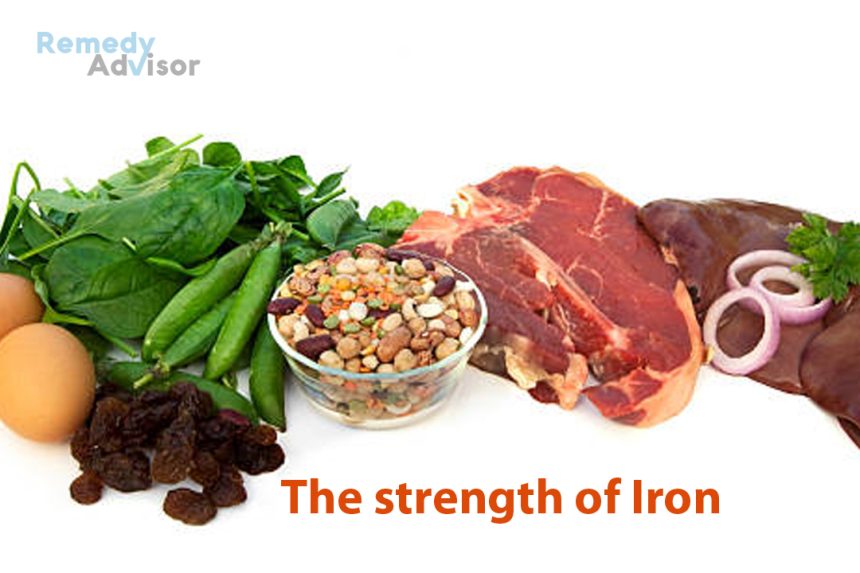“Tired blood” may be a Madison Avenue ploy, but it’s also a real condition brought about by lack of iron in the blood.
Without iron, there would be no hemoglobin, one of the body’s most essential proteins. Red cells are what makes the blood red, but hemoglobin is what makes the red cells red. Hemoglobin’s job is to carry the oxygen from the lungs to the rest of the body. When iron is deficient, hemoglobin is reduced. What results is a decrease in oxygen being transported to the brain and muscles. Headaches, constant fatigue and shortness of breath set in as the lungs try to pump more oxygen into the body. When this happens, you are suffering from iron-deficiency anemia, better known from television commercials as “tired blood.”
Who needs iron?
Women usually do, that’s who. Men usually carry enough iron stored in their bodies to last up to three years. Women, on the other hand, often lack a natural reserve of the mineral. Pregnant women need an extraordinary amount of iron, and women with a normal menstrual flow need twice the amount of iron in a month that men do.
Vegetarians, infants, and people on certain weight-reduction diets also have a difficult time getting enough iron.
A Swedish study that appeared in the American Journal of Clinical Nutrition also suggests that people on an extremely high-bran diet may also be in need of more iron. So may school age children.
Ironing out school problems
When you read your child’s report card, do the teacher’s comments include “short attention span” or “inattentiveness’”’? If so, a lack of iron may be the culprit.
“The newest information suggests a connection between cognitive performance in growing children and a lack of iron,” says James Cook, M.D., head of the Division of Hematology at the University of Kansas Medical Center. “An iron deficiency may cause the child to have a hard time concentrating.”
One study has shown that children with even a mild iron shortage have poorer memory and learn less quickly than kids with adequate iron. In other words, an iron deficiency can lead to an impaired memory. “Children with a subclinical iron deficiency can learn they won’t be retarded but the deficiency will interfere with what they learn,” says Thomas F. Massaro, Ph.D., of Pennsylvania State University.
If you believe this may be the case with your child, feed him more iron-rich foods. “Preferably, all vitamins and minerals should be gotten from our foods,” says Jack M. Cooperman, Ph.D., director of nutrition at New York Medical College. “For the average person, a balanced diet is all we need to supply our body with enough iron and other minerals.”
But getting that balance isn’t always so easy, especially where iron’s concerned.
The irony of iron
For example, in order to stay healthy we are told to exercise and avoid saturated fats. But ironically, while doing so, you may be depleting your body of its iron supply. Studies show that strenuous exercise and heavy sweating can cause losses of this precious metal. Meat, which has plenty of saturated fats, is loaded with iron. ‘The more we exercise and avoid meats, the less iron our body may be receiving.
Even when we eat enough iron, we may not be absorbing enough. What we absorb is influenced by what we eat along with it.
Heavy-metal food
Here’s how to get iron that your body can use.
- Vitamin C will double the amount of iron absorbed by your body. Adding orange or tomato juice, half a grapefruit or strawberries to your meals will increase your iron intake. Include vegetables rich in vitamin C, such as tomatoes, green peppers, broccoli, radishes and leafy green vegetables.
- Eat breads, cereals and pasta that have been iron fortified. Check the label on the package to find out.
- Use blackstrap molasses as a partial replacement for sugars and other sweeteners in your confections. It’s an excellent source of iron.
- Cook with cast-iron pots and pans. By simmering cup of spaghetti sauce for 3 hours in a cast-iron pot, you can raise its iron content from 3 milligrams to 88 milligrams that’s more than eight times the Recommended Dietary Allowance for men and postmenopausal women!
- Eat red meats. They are among the few foods that have high iron content. Choosing lean cuts in small portions will supply your body with plenty of iron and still keep those calorie levels down near those of fish and poultry.
- Include beef, poultry, fish, lamb, veal or game and you will multiply fourfold the iron absorbed from the rest of the meal.
- Avoid drinking coffee and tea with your meals. Tea can reduce your iron absorption by at least 50 percent and coffee by about 39 percent.







